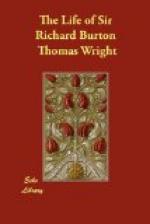Turning to Mr. Cautley, Lady Burton asked: “What religion shall I say?”
“Tell him Sir Richard’s true religion,” replied Mr. Cautley.[FN#636]
She then said, “Catholic.”
“But!” interjected Mr. Cautley.
“Yes,” followed Lady Burton, “he was a Catholic.”
Lady Burton still nursed the hope that Sir Richard was not quite dead. There was life in the brain, she persisted in saying. Would he revive? “For forty-eight hours,” she tells us, “she knelt watching him.” She could not shed a tear. Then she “had the ulnar nerve opened and strong electricity applied to make sure of his death.”
Some months after, when her mind had regained its equilibrium, she observed to Major St. George Burton.[FN#637] “To a Protestant, Dick’s reception into the Holy Church must seem meaningless and void. He was dead before extreme unction was administered; and my sole idea was to satisfy myself that he and I would be buried according to the Catholic rites and lie together above ground in the Catholic cemetery. He was not strictly received, for he was dead, and the formula Si es capax, &c., saved the priest’s face and satisfied the church.” When mortification began to set in, the body, which was found to be covered with scars, the witnesses of a hundred fights, was embalmed, laid out in uniform, and surrounded with candles and wreaths. “He looked so sweet,” says Lady Burton, “such an adorable dignity, like a sleep."[FN#638] Behind the bed still hung the great map of Africa. On his breast Lady Burton had placed a crucifix, and he still wore the steel chain and the “Blessed Virgin Medal,” which she had given him just before the Tanganyika journey.
Priests, pious persons, and children from the orphanage of St. Joseph, in which Lady Burton had taken so much interest, watched and prayed, recited the office for the dead, and sang hymns.
There were three distinct funerals at Trieste, and there was to be another nine months onward in England. All that can be said is that Lady Burton seemed to draw comfort from pageantry and ceremonial that to most mourners would have been only a long-drawn agony.
The procession was a royal one. The coffin was covered with the Union Jack, and behind it were borne on a cushion Burton’s order and medals. Then followed a carriage with a pyramid of wreaths, and lastly, the children of St. Joseph’s orphanage, a regiment of infantry and the governor and officials of Trieste.
Every flag in the town was half-mast high, multitudes thronged the streets, and every window and balcony was crowded. Every head was uncovered. The procession wound its way from the Palazzo Gosleth down the declivity into the city under a bright sun pouring down its full beams, and so onward through the serried masses of spectators to the cemetery. Writing to Lady Stisted,[FN#639] Lady Burton says, “I did not have him buried, but had a private




